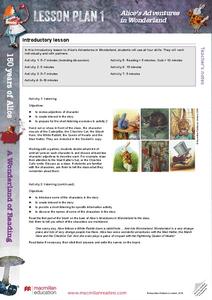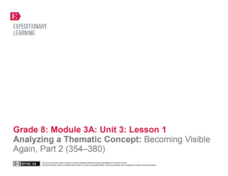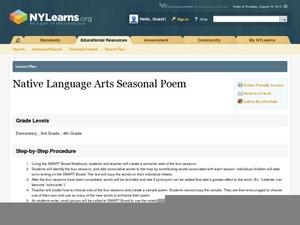Classroom Law Project
Should we believe everything we read? Becoming a discerning consumer of media
Class members investigate the role media should play in a healthy democracy. As part of this study, groups analyze political advertising, use FactCheck to assess not only the veracity of but the persuasions techniques used in candidates'...
EngageNY
Grade 11 ELA Module 2: Unit 1, Lesson 23
Work together for the higher good. Scholars look at paragraph 10 in the "Atlanta Compromise" speech in which Washington pledges African American cooperation. Readers determine the connection between two central ideas and how they build...
Curated OER
Find the Main Idea in Romeo and Juliet
Finding the main idea in a text can be rather difficult! Work with your class and develop this skill. This resource contains an excerpt from Act II, Scene 2 of Romeo and Juliet, and the reader must identify the main idea of Juliet's...
Curated OER
Surveying Salinger with Dialogue and Disillusionment
Find creative ways to teach Salinger's stories by focusing on dialogue, cultural context, and characterization.
Curated OER
Eating Up Idioms
Ah, food idioms! Now that sounds tasty. Class members read and discuss various food-related idioms, create an illustration of a food-related idiom, and develop a class book or bulletin board to celebrate figurative language and National...
Scholastic
Presenting Persuasively (Grades 9-12)
As a review of persuasive techniques, groups develop a one-sentence slogan designed to entice others to purchase a produce or adopt a point of view. The group then craft a storyboard for a commercial for their product.
Curated OER
Editing Marks, Part 1
Dander from the show Twisted Whiskers and characters from My Little Pony are featured in this three part lesson that explores using story pyramids to scaffold ideas, adding sensory details to enrich writing, and editing using common...
Curated OER
The Different Kinds of Connectives
Connectives are words that link clauses or sentences. Conjunctions link clauses with in a sentence, so get ready to bring two thoughts together with this slide show on connectives. Listed are various types of connectives used to compare...
Curated OER
Ser Worksheet 3: Conjugating
Hola! After you've introduced your Spanish language learners to common Spanish verbs, have them complete this worksheet on the verb ser. For each of the 20 sentences, they conjugate the verb to fit correctly in the sentences provided....
Curated OER
Describe common actions and objects in specific and general language
Having a diverse and well-developed vocabulary make for both good readers and good writers. The class discusses basic grammar, such as nouns, verb, and adjectives. They then view a series of pictures and work as a class to create simple...
Curated OER
School to Home Link: Describing Events
Help your young native Spanish speakers develop description skills. With this school-to-home worksheet, parents will help their youngster write a story that uses details. Both the parent and child are asked to sign the sheet-- a...
Macmillan Education
Alice's Adventures in Wonderland
Follow Alice as she travels through Wonderland with a set of lessons based on the first chapter of the book. Learners discuss key moments and ideas from chapter 1 before answering a series of comprehension questions about what they have...
British Council
Unit 6: Enquiries
So many questions! How do people in the business world answer them? Young communicators demonstrate their understanding of correct grammar in the sixth of nine lessons focused on developing career skills. Types of questions range from...
EngageNY
Grade 11 ELA Module 2: Unit 1, Lesson 26
Add all of the pieces to complete the puzzle. Scholars apply their knowledge from the past 25 lessons to an end-of-unit writing assignment. Pupils write multi-paragraph essays comparing the author's point of view and use of rhetoric in...
EngageNY
Analyzing a Thematic Concept: Becoming Visible Again, Part 2 (354–380)
Scholars take a close look at the life of Louie in Unbroken. They discuss events considered turning points in their life and use several graphic organizers and guides to help direct their thinking. After thinking about their responses,...
Curated OER
Run-On Sentences
As kids develop writing skills, run-on sentences are bound to happen. Review what a run-on sentence is with the first part of this instructional activity, and then let them try to correct the 10 run-on sentences provided. Since there are...
Curated OER
Verbals: They look like verbs...but they're not!
Did you know there are three types of verbals? Do you even know what a verbal is? Provide your class with this brief introduction! Participles, infinitives, and gerunds are all introduced, and examples are given. Pair this with a...
Curated OER
Speak Up for Recycling
Are you looking for ways to enhance a persuasive writing or speech unit? Use this lesson to prompt your young writers to investigate a school recycling program. After conducting research, they present a persuasive, well-organized speech...
Curated OER
Word Roots 7: SPECT, STA, VERT Intermediate Synonym or Antonym Word Puzzle
Use word roots to help your class develop vocabulary acquisition skills. This particular resource focuses on the word roots SPECT, STA, and VERT. Leaners choose an antonym and a synonym from a word bank for each of 6 given words, keeping...
Curated OER
Telling a Story
Do your class members complain they don’t know what to write about? Give them disposable cameras and ask them to take pictures of 12 things that make them happy. After the pictures are developed, they are pasted on a poster board and...
Shmoop
ELA.CCSS.ELA-Literacy.RI.9-10.6
What does the author believe about his topic? Why did he write in the first place? Challenge your class to figure out the answers to these questions as they read through informational texts. The resource provides a breakdown of the...
Curated OER
Native Language Arts Seasonal Poem
Intended for native Spanish speakers, this plan provides an opportunity to create a class semantic web describing the different seasons and listen to Vivaldi's "Four Seasons." Learners will work together to revise their semantic webs,...
EngageNY
Studying Conflicting Information: Varying Perspectives on the Pearl Harbor Attack, Part 1
Scholars read President Roosevelt's Day of Infamy speech and analyze the speech's words using close reading guides. Readers determine Roosevelt's point of view after reading the speech and filling in the guides.
EngageNY
Grade 10 ELA Module 2: Unit 3, Lesson 7
It's time to show what you know. The final lesson asks scholars to reflect on the seven-lesson plan unit and complete an end-of-unit task. Readers consider the claims presented in speeches by Eleanor Roosevelt and Malala Yousafzai before...























